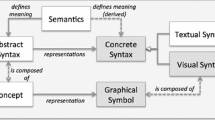Abstract
Conceptual models or diagrams have been used for many years to visually convey information, and they represent a subset of graphic presentation more generally. Historically, they have been used to describe, interpret and explain relationships among concepts deemed relevant to the understanding of some phenomena. This paper makes specific recommendations for increasing the capacity of models to clearly convey a particular form of complexity, that involving multiple contexts or levels of analysis. In particular, the inclusion of negotiated or constructed contexts as contexts, the use of small multiples to create a dialog with orienting models around specification decisions, and the representation of alternate scenarios are recommended.
Similar content being viewed by others
References
Bickel R.: Multilevel Analysis for Applied Research. Guilford Press, New York (2007)
Blalock H.M.: Correlation and causation. Soc. Forces 39, 246–251 (1961)
Blalock H.M.: Causal Inference in Non-experimental Design. University of North Carolina Press, Chapel Hill (1964)
Blakely T., Subramanian S.V.: Multilevel studies. In: Oakes, J.M., Kaufman, J.S. (eds) Methods in Social Epidemiology, pp. 316–340. Jossey-Bass, San Fransisco (2006)
Britt, D.W.: An Introduction to Conceptual Modeling. Lawrence Earlbaum, Manwah. Available on-line at www.questia.com (1997)
Britt D.W.: Beyond elaborating the obvious: Context-dependent parent-involvement scenarios in a preschool program. Appl. Behav. Sci. Rev. 6, 179–197 (1998)
Britt D.W., Campbell E.Q.: Assessing the linkage of norms, environments and deviance. Soc. Forces 56, 532–549 (1977)
Britt D.W., Risinger S.T., Mans M., Evans M.: Devastation and relief: conflicting meanings in discovering fetal anomalies. Ultrasound Obstet. Gynecol. 20, 1–5 (2002)
Diez-Roux A.V.: Bringing context back into epidemiology: variables and fallacies in multi-level analysis. Am. J. Public Health 88, 216–222 (1998)
Dohrenwend B., Dohrenwend B.S.: Socio-environmental factors, stress, and psychopathology. Am. J. Community Psychol. 9, 12–159 (1961)
Earp J.A., Ennett S.T.: Conceptual models for health education research and practice. Health Educ. Res. 6, 163–171 (1991)
Glymour M.M.: Using causal diagrams to understand common problems in social epidemiology. In: Oakes, J.M., Kaufman, J.S. (eds) Methods in Social Epidemiology, pp. 393–428. Jossey-Bass, San Fransisco (2006)
Greenland S., Pearl J., Robins J.M.: Causal diagrams for epidemiologic research. Epidemiology 10, 37–48 (1999)
Krieger N.: Epidemiology and the web of causation: has anyone seen the spider?. Soc. Sci. Med. 39, 887–903 (1994)
Merlo J., Chaix B., Yang M., Lynch J., Râstam.: A brief conceptual tutorial on multilevel analysis in social epidemiology: interpreting neighborhood differences and the effect of neighborhood characteristics on individual health. J. Epidemiol. Community Health 59, 1022–1029 (2005)
Otten R., Wanner B., Vitaro F., Engels R.C.M.E.: Disruptiveness, per experiences and adolescent smoking: a long-term longitudinal approach. Addiction 104, 641–650 (2009)
Paradies I., Stevens W.: Conceptual diagrams in public health research. J. Epidemiol. Community Health 59, 1012–1013 (2009)
Pearl J.: Causality. Cambridge University Press, Cambridge (2009)
Ragin C.: The Comparative Method. University of California Press, Berkeley (1987)
Richiardi L., Barone-Adesi F., Merletti F., Pearce N.: Using directed acyclic graphs to consider adjustment for socioeconomic status in occupational cancer studies. J. Epidemiol. Community Health 62, e14–e20 (2008)
Rothman K.J.: Causes. Am. J. Epidemiol. 104, 587–592 (1976)
Rothman K.J., Greenland S.: Causation and causal inference in epidemiology. Am. J. Public Health 95(Suppl 1), S144 (2005)
Simon, H.A.: Causal ordering and identifiability. In: Hood, W.C., Koopmans, T.C. Studies in Econometric Method, pp. 49–74. John Wiley, New York (1953)
Starfield B.: Equity in health. J. Epidemiol. Community Health 56, 483–484 (2002)
Tufte E.R.: The Visual Display of Quantitative Information. Graphics Press, Cheshire (1982)
Tufte E.R.: Envisioning Information. Graphics Press, Cheshire (1990)
Turner L., Mermelstein R., Flay B.: Individual and contextual influences on adolescent smoking. Ann. N Y Acad. Sci. 1021, 175–197 (2004)
Wilcox P.: An ecological approach to understanding youth smoking rajectories: problems and prospects. Addiction 98(Suppl1), 57–77 (2003)
Author information
Authors and Affiliations
Corresponding author
Rights and permissions
About this article
Cite this article
Britt, D.W., Chen, YC. Increasing the capacity of conceptual diagrams to embrace contextual complexity. Qual Quant 47, 567–576 (2013). https://doi.org/10.1007/s11135-011-9479-0
Published:
Issue Date:
DOI: https://doi.org/10.1007/s11135-011-9479-0




